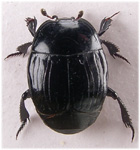0.8-10mm. Antennae characteristic: geniculate with a solid club usually formed of three fused segments. Convex oval or cylindrical and usually shining , elytra truncate leaving the pygidium and propygidium exposed. Tibiae generally toothed and flattened, ventrally folded to receive the tarsi, and pronotum variously excavate to accomodate retracted antennae, the whole form becomes globular when the beetle is alarmed. Tarsi 5-5-5, 5-5-4 in the Acritini, and simple.
Abraeinae includes eight species in five genera. They are small species, 3.2mm. at most. With the exception of Plegaderus vulneratus (Panz.) � they are keyed in Halstead. Our two species of Abraeus (1-1.5mm) are local throughout England ocurring in rotten wood of various broad leaved trees. Plegaderus dissectus Eich. (1-1.5mm.) is rare in southern England and the midlands in rotten deciduous timber. Acritus nigricornis (Hoff.) is common and widespread among decaying vegetation. A.homoeopathicus Woll. is associated with fungus (Pyronema confluens is quoted in Halstead) on burnt ground in the southeast. Aeletes atomarius (Aube) is a very local southern english species associated with Dorcus burrows. Halacritus punctum (Aube) (1.1.4mm) is an english maritime species found under seaweed and on sand above the high tide levels. Teretrius fabricii Mazur (=T.picipes (F.) in Halstead), 1.8-2.2mm is very rare in southern England, associated with wood where it preys on Bostrychid species.
�See Allen, A.A. 1968 Ent.Mon.Mag. 104:110-112 for identification details.
Saprininae includes fifteen species in four genera. Six species of Saprinus (2.8-7mm) are generally associated with dung or carrion. Saprinus virescens (Paykull), a rare english species, preys on Phaedon larvae and bears a superficial resemblance to the adults. S.subnitescens Bickhardt is included on the british list on the strength of 2 old (19C) records and is now a suspected immigrant. Several Saprinus species are common. Our Five species of Hypocaccus (2.5-5mm) are associated with dung and carrion, all are rare or very local and generally found near the coast. H.dimidiatus (Ill.) keys out as baeckmanniolus maritimus (Steph.) in Halstead, H.crassipes (Er.) was added to the british list by Lackner � in 2005 from a single specimen found in John Owen's collection, 1974 Pembrey, south Wales. Our four species of Gnathoncus (1.8-4mm) are found in birds nests in hollow trees ( Alexander) and occasiionally fungi, granaries or carrion. All are local or rare. Identification can be difficult without comparative material, males need to be dissected to be sure. Myrmetes paykulli Kanaar (keyed as M.piceus) (paykull) in Halstead) is local throughout England and Scotland and associated with the ant Formica rufa L. All species of Saprininae are keyed in Halstead.
� Lackner,T. 2005. Hypocaccus crassipes (Er.) a new species for the fauna of Great Britain. Entomological Problems 15(1):46. Includes a key to all british Hypocaccus species.
Dendrophilinae includes 4 genera and 7 species. Two of our three Dendrophilus species (2-4mm.), D.pygmaeus (L.) and D.punctatus (Hbst.) are associated with the ant Formica rufa (L.), punctatus is also found among carrion and in birds nests in hollow trees (Alexander). Both are local. D.xaveri Marsuel is a native of Japan formerly found in grain and flour warehouses in Bristol, London and Liverpool (Halstead). Kissiter minimus (Aube) is featured. Carcinops pumilio (Er.)(1.6-2.8mm.) is a local english species found in carrion, decaying vegetable matter and bat dung (Halstead). Paromalus flavicornis (Hbst.) is widespread and local across southern England under bark or in rotting wood and fungi. P.parallelopipidus (Hbst.) is a rare New Forest species found under bark.
Onthophilinae includes two species of Onthophilus (1.8-2.4mm.) O.striatus (Forster) is common throughout England in dung, leaf litter and rotting vegetation, they turn up in extractions from many different habitats. O.punctatus (Muller, O.F.) is a rare English species found in mole's nests (Halstead), but if this is its only habitat its distribution must surely be open to investigation.
Tribalinae includes only Epierus comptus Er. (2-3mm.), added to the british list by Nash � in 1982. A very rare insect found under Beech bark near Salisbury, Wiltshire.
� Nash, D.R. 1982 Ent.Rec.J.Var. 94:165-167 for a a description and key to european members of the Tribalini.
Histerinae includes 3 genera and 15 species, these are large, 3.5-11mm., mostly black insects of distinctive build, some are very common in dung, carrion or rotting fungi and so will be most coleopterists introduction to the group. Atholus bimaculatus (L.)(3.5-4.5mm.) is local and widespread in dung. Our other species, A.duodecimstriatus (Schrank) is local and found in dung and compost throughout England and southern Scotland. Two species of Hister are locally common, H.unicolor L. and H.bisexstriatus F., from dung, decaying vegetable matter and carrion. A third, H.quadrimaculatus L. is a very rare southern english species. Two more species are on the british list, H.illigeri Duft. and H.quadrimaculatus Scriba, both very rare former residents now considered extinct. Of our eight species of Margarinotus one, M.obscurus (Kugelann) was last recorded in 1947 from Devon and is now considered extinct. M.marginatus (Er.) is local in England and Scotland, found in moles nests. M.stercorarius (Hoffmann, J.J.) is very rare from southern England, found in dung. Our other species are either common or locally common and should be expected from our area.
Hetaeriinae includes only Hetaerius ferrugineus (Ol.)(1.5-2mm) a very rare southeastern english specis associated with the ants Formica fusca L. and F.sanguinea Lat.
Halsteads handbook covers all our species with the exception of the two extinct Hister species, Plegaderus vulneratus and Epeirus comptus which are referenced above. Joy's key, although out of date in the sense that a dozen or so species from our modern list are omitted, is still useful in many cases. The family is dealt with by Witzgall, K. in Vol.3 of Die Kafer Mitteleuropas (1971) as always, in German.
Plegaderus
dissectus
Abraeus
Acritus
Gnathoncus
Hypocaccus
Saprinus
Dendrophilus
Paromalus
Onthophilus striatus

Atholus
bimaculatus

Hister
unicolor
Hister
unicolor
Hister
unicolor

Margarinotus
brunneus
Margarinotus
brunneus
Margarinotus
brunneus
Margarinotus
brunneus
Margarinotus
brunneus
Margarinotus
merdarius
Margarinotus
purpurascens
Margarinotus
striola
Margarinotus
striola
Margarinotus
striola
Margarinotus
ventralis
Margarinotus
ventralis
Margarinotus
ventralis
Home